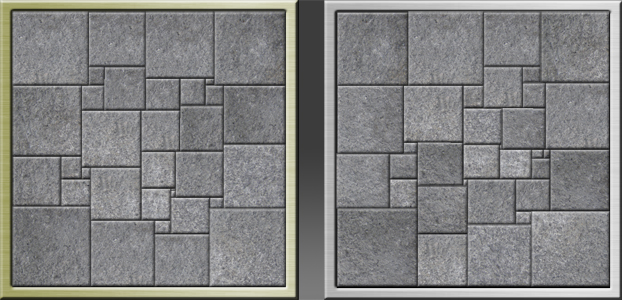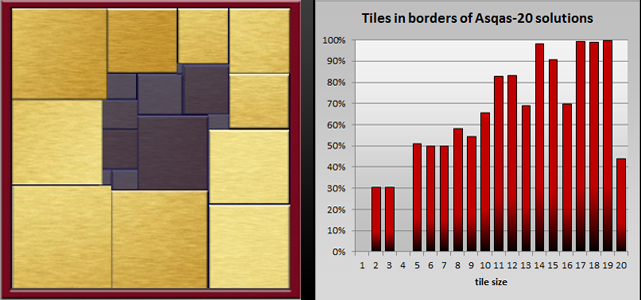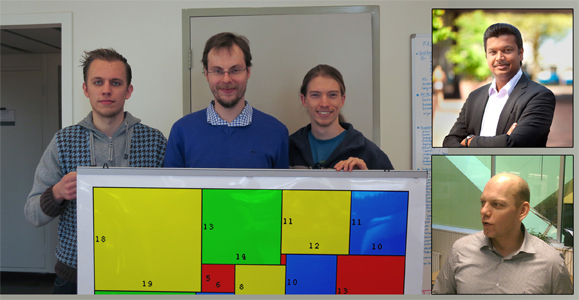MeesterDaan (talk | contribs) (→How did you solve it?) |
MeesterDaan (talk | contribs) (→How did you solve those 4,4 million borders?) |
||
| Line 39: | Line 39: | ||
</Center> | </Center> | ||
| − | ==How did you solve | + | ==How did you solve the 4,4 million borders?== |
<Center> | <Center> | ||
| − | {| align=" | + | {| align="justify" | style=" align="top"; text-align: center; margin-left: 1em; margin-bottom: 1em; font-size: 100%;" |
|- | |- | ||
|valign="top"| | |valign="top"| | ||
| Line 52: | Line 52: | ||
|} | |} | ||
</Center> | </Center> | ||
| + | |||
==So, is this a hard problem?== | ==So, is this a hard problem?== | ||
<Center> | <Center> | ||
Revision as of 22:28, 21 November 2016
Contents
Paper
I'm still working on this page, but our paper is here. I (Daan van den Berg) welcome all feedback you might have. Look me up in the UvA-directory, on LinkedIn or FaceBook.
What is ASQAS-34 ?
|
ASQAS-34 is a Perfect Rectangle Packing Problem. In general, rectangle packing problems involve putting a set of rectangles inside a rectangular frame (often called a "container"). Those problems requires that you find the smallest container possible, hence it is an constrained optimization problem. In perfect rectangle packing problems, the frame has exactly the same area of all the rectangles summed up. This means that if it fits, it fits perfectly, without free space or overlap in the rectangles, and a smaller container does not exist. Therefore, perfect rectangle packing problems such as ASQAS-34, are constraint satisfaction problems (or equivalently: a decision problem).
|
How did you solve it?
|
With 1048 possible configurations, this problem was way too big to solve on a stand-alone computer. So we needed some tricks to tip the odds in our favour. Such tricka are called "heuristics" if they involve an element of guessing, and "optimizations" if they just speed up the computation process.
|
How did you solve the 4,4 million borders?
|
So then we needed to solve 4,4 million puzzles of 22 tiles - the interior of the borders. One puzzle of 22 tiles is too difficult to solve on one computer, so we still had a serious problem. We programmed an 'interior solver' - a small, efficient computer program capable of puzzling the 22 remaining tiles inside the borders. We put multiple copies of this program on scientific supercomputers throughout The Netherlands, and set up a central server to distribute the borders, in batches of 1,000 over the supercomputers.
|
So, is this a hard problem?
|
That's a very difficult question. I don't know. It took us 80 full-time calculation days on 1,000 computers, and we think we used a pretty clever approach. But then there's [Giovanni Resta], an Italian guy who solved the exact same problem on his desktop computer. So is Resta brilliant, or just lucky? Probably a little bit of both. Or maybe the problem isn't so hard after all. But if it wasn't that hard, why did it take us 80,000 computer days? I just don't know, to be honest.
|
 Left: solution found on the server of Cees van Leeuwen's [lab for perceptual dynamics] in Leuven. Thanks to Marco Maas for helping out too. Right: solution found on the astronomical supercomputer ASTRON in Dwingeloo, The Netherlands |
Who are you guys?
|
We are a genuine VU-UvA consortium. Mark, Florian and Emiel were VU-students when we started this work. They're all professionals now, and Emiel does some occasional work in proofreading Heuristics-reports at the UvA. That's where I work, in the "minor programming" (www.mprog.nl) where we teach the course of Heuristics. That course was originally built up at the VU back when I worked there with Guszti Eiben and Bushra Malik. Sandjai, our senior author, also works at the VU as a Full Professor Business Analytics. He works on state-space reductions which is exactly the trick we deployed to solve ASQAS-34. So there's connections all over, we're truly a VU-UvA team. |



